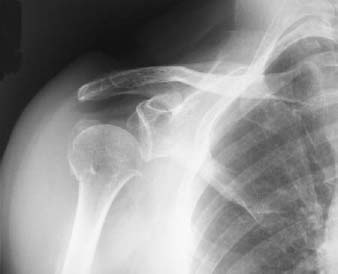CASE 81 Hema N. Choudur, Anthony G. Ryan, and Peter L. Munk A middle-aged woman slipped on snow, landing on her outstretched hand. In the ensuing hours, she had severe pain, swelling, and tenderness in the shoulder with decreased mobility of the right arm. Figure 81A An anteroposterior (AP) upright view radiograph of the right shoulder (Fig. 81A) shows a two-part fracture comprising an undisplaced fracture of the surgical neck of the humerus and a minimally displaced fracture of the greater tuberosity. An associated fat-fluid level is shown within the shoulder joint. The glenohumeral and acromioclavicular articulations are normal. Undisplaced proximal humeral fracture involving the surgical neck of the right humerus and greater tuberosity with associated lipohemarthrosis. Dislocation must be differentiated from pseudosubluxation, and true fractures from pathologic, insufficiency, and stress fractures. Proximal humeral fractures are not uncommon and account for 5 to 10% of fractures. Although nondisplaced and minimally displaced fractures are the most common and are fairly easy to treat, grossly displaced fractures pose a challenge. The most common etiology is a fall on the outstretched hand. The humerus is severely abducted, resulting in a fracture. Direct blows on the arm can sometimes result in similar fractures. These fractures are more common in women than men and are usually secondary to osteopenia in the elderly. Younger individuals can present with similar injuries secondary to sports-related trauma. The type and extent of the fracture depend on the age of the patient and the mineralization of the bones. Physeal injuries occur in childhood. Dislocations are more common in younger individuals and proximal humeral fractures in the middle-aged and elderly. Most of these fractures are undisplaced or minimally displaced due to the protection offered by the rotator cuff and surrounding muscles, capsule, and periosteum. Following a proximal humeral fracture, the upper fragment is usually abducted and externally rotated by the external rotators, while the lower fragment is adducted and internally rotated by the internal rotators. Comminuted and significantly displaced fractures of the neck can cause injury to the blood supply of the humeral head. The main blood supply to the humeral head arises from the anterolateral branch of the anterior humeral circumflex artery. This vessel passes lateral to the long head of the biceps and forms the arcuate artery. The arcuate artery arises from the ascending branch of the anterior humeral circumflex artery as it penetrates bone. It enters into the humeral head in the area of the intertubercular groove and gives branches to the lesser and greater tuberosities. It perfuses the entire epiphysis of the humeral head. The posterior circumflex artery supplies only a small area in the posteroinferior aspect of the humeral head. As the shoulder is surrounded by a bulk of muscles, radiographic assessment is essential to rule out a clinically suspected fracture. Pain, tenderness, focal swelling, and inability to move the arm are the common presenting complaints following either a fall or a sports-related injury. The clinical examination also helps to rule out a vascular/nerve injury. If the arm is swollen and red, axillary artery compromise is suspected, and an angiogram is indicated. Other vessels that can be injured are the anterior and posterior circumflex arteries and the ascending humeral circumflex artery. The brachial plexus and axillary nerve may also be injured. The fat that escapes into the joint, from the bone marrow, following the fracture is seen as a lucent layer over the radiodense blood-fluid layer because of its lighter weight (Fig. 81B).
Shoulder and Proximal Humeral Fractures
Clinical Presentation

Radiologic Findings
Diagnosis
Differential Diagnosis
Discussion
Background
Etiology
Pathophysiology
Clinical Findings
Complications
LIPOHEMARTHROSIS
Stay updated, free articles. Join our Telegram channel

Full access? Get Clinical Tree


